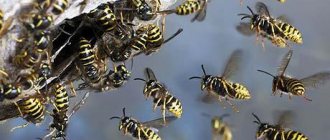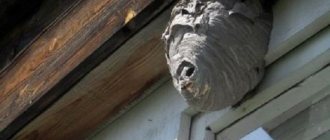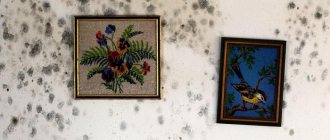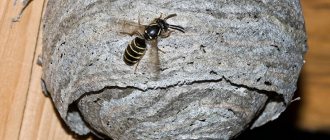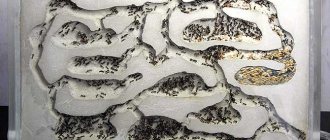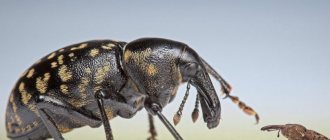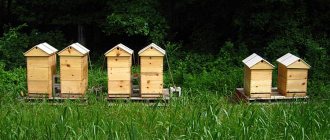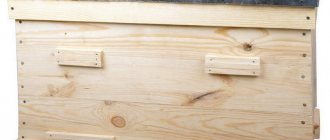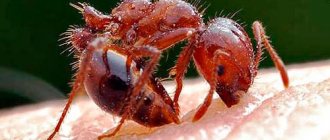Hornet (lat. Vespa, that is, wasp) is a social insect of the same year. The prevailing discipline and caste system in the swarm subordinates its short life to a single rule: to do everything necessary to procreate. It is generally believed that giant wasps are spontaneous in their aggression, but this is not the case, and the attack is a way for the hornet to protect the nest. Often, guarding possessions whose proximity a person may not even be aware of, these insects attack the offender. In such situations, no matter how much you want to coexist peacefully, you have to make a choice in favor of the safety of your own family. There are several ways to combat hornets that are suitable for home and garden use.
What do hornets look like and why are they dangerous?
Externally, hornets are very similar to ordinary wasps, but they are very easy to distinguish by their large size. This insect can be described as follows:
- The body length depends on the specific subspecies, but the most common individuals are 3-5 cm, and their wingspan can be up to 7 cm.
- The body is striped and has a yellow-black color characteristic of this species.
- The abdominal cavity is most often dark brown.
- The head grows into the chest, this area is black.
These insects can pose a serious danger because their bites have the following features:
- Instant manifestation of an extremely acute allergic reaction and inflammatory processes , since the venom contains a large number of different substances and is close in composition to the venom of a rattlesnake.
- The hornet does not die after being bitten and is able to sting its target several more times.
- The bites are painful. According to various studies, only certain varieties of exotic ants are capable of stinging more painfully.
- Single individuals are capable of transmitting signals to their relatives at a distance , so in case of death or danger, help may arrive, and a person tolerates a large number of bites extremely poorly.
- People with various diseases have a hard time with bites , since they can negatively affect cardiac or respiratory activity, as well as many systems of the human body.
- If a child is bitten, internal organs may be damaged.
The danger of giant wasps
Despite all the fears, the hornet is a peace-loving insect; they bite only when necessary to protect themselves and their own nest. Those who approach their home at a distance of less than two or three meters are perceived as aggressors and are attacked with stings by the guards.
When bitten, poison is injected, the composition of which includes toxins - they cause severe pain and allergies in the body. They are especially dangerous for the immune system of children.
Note that the consequences of a bite can be different - it all depends on how much poison was injected, as well as the characteristics of the human body. Everything can be done with the usual swelling and pain, some experience anaphylactic shock, and there have been cases of death.
Ways to get rid of insects
Sometimes people and hornets can get along well, but in some situations the insects build their nests in undesirable places, posing a threat to others.
In such cases, you have to get rid of them; this can be done in different ways:
- Setting traps often cannot completely get rid of unwanted neighbors, but it allows you to destroy individual individuals that get too close to a person or territory where they should not be.
- The use of various chemicals, most often aerosols containing insecticides. This technique is one of the most effective, and it allows you to get rid of insects instantly. However, the use of insecticides also has a certain risk, since it may not be possible to destroy the hornets the first time, and such an attack will anger the inhabitants of the nest and provoke them to launch a counterattack.
- Call professionals from specialized services that deal with the destruction of all types of insects. This method is the most recommended, since it allows you to get not only a guaranteed result, but also protection from the reappearance of unwanted neighbors for a certain period of time. The only drawback of this option is the very high cost compared to other methods.
There are other ways to combat hornets, but the options discussed are the most popular, since other analogues are more dangerous. Regardless of the chosen method, they all boil down to one thing - the need to destroy the nest.
Spray effectiveness
You need to purchase a special anti-hornet spray at the store. Buy the cheapest spray. You need to know that all sprays work the same, so you shouldn't waste your money. The country of manufacture is not important and the larger the capacity, the better. If the nest is large, then buy two aerosols, but only against hornets
Pay attention to the inscription on the can; there should be no information about insects other than hornets.
It is best to carry out treatment in the early morning before dawn, since at this time the hornets are still sleeping and do not fly. The spray will kill the hornets, but it is dangerous for humans, and you need to protect yourself with a gas mask. Despite the protection, you must act quickly and get within three meters of the nest. Start spraying as you get closer. The nest should be well soaked. After treatment, move away. It's worth letting the couples dissipate. To help the fumes dissipate faster, you can create a draft or bring a powerful fan into the attic to help get rid of toxic fumes. Inspect the nest and if you are satisfied with the result, leave the attic and return to it after three days. Remove the nest, put it in a bag and burn it. Hornets that try to return to the nest will also die. Therefore, the nest should hang for another two to three days.
It is important that there are no small children or pets in the house at this time. It's best to take them out of the house for a couple of days
Hornets and wasps are very “ambiguous” neighbors of humans. On the one hand, with their presence at the dacha they prevent its owner from relaxing, forcing him to constantly be on alert for the possibility of getting bitten. On the other hand, being natural predators, they are capable of destroying harmful agricultural insects in significant quantities.
Thus, residents of just one daily bring up to several hundred different caterpillars, bugs and butterflies into their homes, thereby helping gardeners and gardeners fight for the harvest. Therefore, before getting rid of hornets or wasps, you should make sure that there is no possibility of peaceful coexistence with them on the site.
However, there are times when the need to get rid of a hornet nest arises, as they say, here and now. If, for example, the home of these insects appears not far from an apiary, then they will definitely hunt bees, and when the colony grows, they will actively destroy their hives.
It is logical that beekeepers are unlikely to put up with this state of affairs and will eventually begin to actively exterminate predators, protecting bee hives.
At the same time, knowing what hornets are afraid of, destroying them is not so difficult.
Despite all the advantages of exterminating harmful insects, hornets in the country can also have a significant disadvantage - their proximity poses a serious threat to the health of children and adults. One or two large wasps that accidentally fly into the area are not yet so dangerous, but a family that has settled for permanent residence can cause serious consequences.
In the event of an attack on a person by ordinary wasps, serious damage is observed only occasionally; their bites are simply painful. If a hornet is taken for the “deed,” then the consequences of meeting it can be truly terrible.
Hornet traps
A variety of hornet traps are very popular; stores today have a wide range of similar devices.
However, you can make them yourself; one of these options is discussed in detail below:
- Prepare a plastic bottle with a volume of at least 1.5 liters and cut off its top part with the neck.
- A fragrant bait is poured into the lower part, which will attract the attention of insects. You can use jam, honey or beer, and also mix these components with each other.
- The top of the bottle is inserted into the bottom, neck down. In this case, you must remember to remove the cover from it.
- As an additional measure, the neck can be lubricated with any oil, after which the trap will be ready. The hornets, flying towards the smell, will get caught inside, but will not be able to get out, since they will look for a way out exclusively along the side surfaces of the bottle. If some individuals get to the neck, they will not be able to get out due to the slippery coating on it.
This is due to the fact that the baits used will also attract the attention of bees, which will die along with the hornets.
Apiary protection
A person and a hornet can exist peacefully only if their homes are located at a great distance from each other. If we talk about the proximity of hornets and bees, then this option is a priori not possible, since the first of them love honey and bees as a delicacy.
They catch bees when they are near the hive or when flying out to collect nectar. Insects carry such prey to the nest to feed to the larvae and the queen. In the case of a large number of insects, the apiary suffers greatly - one individual can kill 30 bees at a time. If large wasps have appeared on the site, then you need to remove or drive them out as quickly as possible.
Locating the Nest
Regardless of the chosen method of destroying hornets, the first priority is to find their nest.
In some cases, this process does not take a significant amount of time or effort, and the nest can be found somewhere near the site, for example, in trees or in utility rooms; it is simply impossible not to notice it.
However, situations arise when the hornets’ home is securely hidden, and it is not possible to monitor where they are flying; in this case, you can use the old and proven method of determining the location of the nest:
- Hunt down one of the hornets and knock it down with a tennis
with a racket, and it is important not to kill him, but only to stun him. At the same time, care must be taken so that his relatives do not consider this a manifestation of aggression and go into an active attack. - Wear a thick leather or rubber glove on your hand to prevent the possibility of a dangerous bite.
- Take a long colored ribbon or thread and tie it around the stunned insect.
- Wait for the moment when the hornet comes to its senses. After this, he will go directly to the nest, and, thanks to the noticeable tape, it will be easy to track the trajectory of his flight.
First, you can try to wander around the area and try to locate the nest visually.
It is recommended to pay attention to the following places that these insects often choose to build their homes:
- Trees, especially if they have spreading branches that reliably hide the nest from prying eyes.
- Old stumps.
- Attics, sheds and various utility rooms , where people look extremely rarely and do not disturb these inhabitants.
- Under the roof of residential buildings.
- In holes dug in the ground. At the same time, the hornets themselves actually never create tunnels on their own; they use those that were made by other types of insects or underground animals.
Intelligence first
Since predators flying into your area do not necessarily settle down within your line of sight, the first thing you should do before fighting hornets is to find out where their home is located. After all, these predators can fly several kilometers from the nest.
Experienced beekeepers use a trap or bait to catch one of the insects, attach a red thread to it and then track the route. It’s easier to tie an insect with a bright thread or ribbon with two people.
This procedure requires extreme caution and compliance with all safety rules, otherwise such an experiment will end in failure.
So, the stages of fighting these insects are as follows:
- reconnaissance of the location of the hive;
- destruction of adults;
- destruction of the nest.
If the hornets have settled very close, then it is much easier to follow the giant wasps and find out where their hive is. In the case when the discovered nest is of impressive size and there are a lot of insects in it, it is better not to think about how to win the war with hornets on your own.
It would be wiser to call a special pest control service.
Methods for destroying a nest
There are many ways to destroy a hornet’s home, but they are all associated with a certain danger, since these insects are ready to defend their nests to the last.
The following are the most common techniques:
- One of the oldest methods that people have long used is to immerse the nest in a container of water. In this case, you do not need to remove or touch it yourself; you need to place a bucket of water below so that the hive and its inhabitants are completely immersed in it. This option is best practiced indoors, since it often takes a lot of time to completely destroy a population, and the bucket can not be held by hand, but supported with a stepladder or other object.
- The simplest, most effective and favorite method by many is burning the nest, which is first doused with gasoline, kerosene or other flammable substances. The disadvantage is that this option is unsuitable for practical use near trees, wooden buildings, indoors and other places where a fire may occur.
- Spraying the inside of a sealed bag with any insecticide that poses a mortal danger to flying insects and wrapping it around the nest.
- Pouring liquid insecticide or water brought to a boil into holes that lead to underground hornet shelters. However, it must be taken into account that the tunnels can be very deep, so sometimes a very large volume of liquid is required.
- The easiest way to destroy nests that are located in tree hollows is to fill them with toxic substances or simply fill the hole with putty, after which the hornets will be walled up inside.
Destroying the root
Quite often the home of insects is in the attic. If you have found it, you can get to work
But it’s important not to forget about safety precautions, because we are talking about a family of insects that can attack. The first tip is to carry out the “mission” when it’s already dark and the family is resting
At night they are not as active, and you can destroy both insects and larvae.
You need to have a protective suit (beekeeper's clothing or other thick fabric). The entire body must be completely protected. In addition, immediately think of an escape route if you fail in order to take cover. We will look at three ways to get rid of your home:
- Using the package.
- Use of insecticides.
- Pouring and burning.
Plastic bag
When the home is made in the shape of a ball and hangs on the ceiling, rafters, etc., you can put everything in a bag
At night, carefully and carefully, with a quick movement, pull the bag over the nest, tear it off and quickly tie up the contents
Note! The package must be intact and strong. Leave the package
The insects will die in it within a few hours. To speed up the process, the bag can be lubricated with an insecticidal agent in advance. When the nest is not round, and is in such a place that it cannot be torn off, the technology is as follows: pull the bag over the nest, and glue the top of the bag with tape to the nest. This time the bag definitely needs to be lubricated with the product
Leave the package. The insects will die in it within a few hours. To speed up the process, the bag can be lubricated with an insecticidal agent in advance. When the nest is not round, and is in such a place that it cannot be torn off, the technology is as follows: pull the bag over the nest, and glue the top of the bag with tape to the nest. This time the bag definitely needs to be lubricated with the product.
If we talk about the disadvantage of the method, it is that it is important to have agility and dexterity. Yes, and the tape may not stick to the surface.
But now you know how to get rid of a wasp's nest.
We use insecticides
If you cannot get close to the nest and remove it, aerosol cans with insecticides will come to the rescue. To eradicate them, use the products “Raid”, “Kombat”, “Dichlorvos Eco”.
The method consists of spraying the nest, namely its entrance. The action of the drugs is effective: individuals that crawl along the treated surface will die, poisoning other residents in the nest. To enhance the effect, you can increase the dose. Spray the entrance every few days until all the wasps or hornets die out.
Fire and Water
If we are talking about the roof, then using fire is not recommended. Only if the wasp nest is placed in a non-residential building, ground or stone building. The method is fast and effective. It is enough to pour gasoline or a flammable substance over the nest, light a match and burn the wasps or hornets.
If a wasp nest is placed on a roof where fire cannot be used, there is another method - pour liquid insecticide into the nest. Don’t forget to cover the entrance with a rag that is also soaked in the product. Then the wasps or hornets will not fly away. Instead of a toxin, you can use water, preferably boiling water. This method is not as effective, but it works. After filling the wasp's nest with water, the entrance must be plugged. Use a stone or something else.
That's all, in these simple ways you can get rid of insects by eliminating their habitat. After this, neither wasps nor hornets will bother you. What to do if insects just fly to you? They don't have a nest in the attic, but they go there? Or are you simply physically unable to get to the nest? Let's find out.
Safety regulations
Regardless of the chosen method of getting rid of unwanted neighbors, you must remember how dangerous these insects can be, especially in large numbers.
For this reason, it is important to follow the following rules, which will increase the degree of human safety during the procedure:
- First of all, you need to choose the right clothes; they should be tight enough and not leave exposed areas of the body. Thick gloves are put on your hands, and your face should be protected with a special mesh mask, which is usually used by beekeepers.
- You should not make sudden movements or try to escape, even if the inhabitants of the nest go on the attack and try to sting your clothes. You need to calmly move to a safe distance.
- Prepare in advance all the necessary supplies that may be required to provide first aid : alcohol, ice, bandages, medications to reduce an allergic reaction.
- Do not use potentially dangerous methods of killing hornets , such as fire, if this can lead to negative consequences.
- There is no need to make noise near the nest so that its inhabitants do not find out ahead of time that uninvited guests have come to them.
- It is recommended to carry out removal only at night. However, even then the hornets do not sleep, they simply reduce their level of activity, but are ready to quickly mobilize if a threat arises.
Prevention
As such, there are no preventive measures to combat hornets in a private home or country house. These are ordinary insects, and they fly wherever they want. However, maintaining cleanliness in the area, timely removal of food waste and overripe fruits give positive results.
Hornets, not finding available food, fly away in search of a more suitable place. Do not forget to carefully inspect all places where the nest of these large wasps may be “hiding”. Destroy them immediately, preferably by burning them. And don’t forget about personal protective equipment.
Calling specialists
This method of exterminating hornets is the safest, since the employees of the selected organization will do all the work themselves.
This option has several features that need to be taken into account:
- Today there are a lot of companies specializing in insect control , so it is recommended not to rush into making a choice, but to compare different options based on criteria such as pricing policy and customer reviews.
- Discuss important nuances, including guarantees that insects will not appear again. This information must be included in the contract, which is concluded in writing.
- The problem of removing hornets is more typical for suburban areas, and this is one of the criteria that affects the price of the service. Typically, the farther from the city the place where the nest needs to be destroyed is located, the higher the price for this procedure.
The main reasons for the appearance of hornets on the site or in the house
The hornet's habitat is quite extensive: almost the entire southern and northern hemispheres of the globe. In our country, this insect is found everywhere, but especially large populations live in the European part and in the south. A key factor in hornet sightings is the presence of a food source. In particularly dry years, the founding queen travels considerable distances in search of food. It is possible that this journey may end in a gardening area or in the city.
The length of the hornet is usually 1.8–3.5 cm
On human territory, insects most often build nests in remote, quiet and dry corners: in attics, balconies and attics, in basements, garages, premises for livestock and poultry, uninhabited barns, etc. In rare cases, a home for a young swarm can become a former birdhouse, tree hollow or soil.
In areas with a warm climate, where the upper layers of the soil warm up well, hornets make their nests in the soil
According to the type of food, hornets are predators, however, they do not refuse plant foods, including any sugar-containing products, berries and fruits (including rotten ones), and flower nectars. Insects also love to feast on the sap of trees such as oak and birch, so in search of a new site they can fly from an oak grove or birch grove. Honey bees are a special delicacy for giant wasps. The proximity of an apiary is a common reason for the appearance of hornets.
Hornets not only destroy bees, but also take all the honey, pollen and larvae to feed the growing young
Those who have dealt with hornets know about the tireless nature of these insects. There is even an opinion among people that they never sleep, and this is not far from the truth. With a sufficient amount of food and the absence of enemies (and the hornet has no natural enemies anyway), in one season the colony can grow from several hundred to several thousand individuals. Often, giant wasps are lured to a human home by various aromas, which may include a lush flowerbed, or rotting waste, such as meat or fish remains.
So, the reasons for the appearance of a hornet are as follows:
- an unkempt garden plot with a large number of pests (a source of food for hornets);
- cluttered balcony, courtyard, etc.;
- close location of the apiary;
- young tree branches not collected in time;
- an abundance of rotting waste: an open compost pit, trash cans without lids;
- active flowering of ornamental plants and fruit trees;
- the presence of a forest, birch grove or oak grove nearby.
Why is a hornet dangerous?
A hornet sting is extremely painful, it is much more dangerous than a wasp or bee sting. The fact is that the portion of poison injected into the wound is relatively larger (about 2 mg, which is 2.5 times the amount left by the bee) and more toxic. In addition, during an attack, an insect can sting more than once. In most cases, a hornet bite is accompanied by toxic and allergic reactions. An interesting fact is that far from the mother’s nest the insect behaves rather indifferently towards humans. But approaching the hive causes aggression in him.
During an attack or death, the hornet releases a special alarm pheromone, which will quickly alert other family members of the danger. Therefore, it is strictly not recommended to kill an insect near the nest.
If we talk about sensations, a hornet’s bite is usually compared to a hot nail sharply piercing into the body.
First aid for insect bites
If the hornet still managed to sting a person, then you need to act extremely quickly and not waste time in order to avoid possible complications.
Providing first aid consists of the following actions:
- Suctioning venom from the stung area. This procedure must be carried out immediately, since its effect will only be for a short time after the bite, before the poison has time to spread. This will not completely prevent all consequences and get rid of an allergic reaction, but it will significantly minimize the risk.
- Apply ice or any fairly cold compress to the bite site, which will reduce pain and prevent the growth of the lesion.
- Do not touch the affected area and do not allow the bitten person to do so, since any rubbing and scratching will stimulate blood circulation, which will ensure the spread of poison throughout the body, not to mention the possibility of infection, which can significantly aggravate the situation. There is also no need to try to detect the sting, since hornets, unlike bees, never leave it at the site of the bite. This is due to the peculiarity of the structure of their poisonous weapon, which has a smooth surface.
- Use any method to disinfect the affected area; for this you can use hydrogen peroxide, medical alcohol or other disinfectants. You need to treat the bite area with extreme caution, without pressing on it.
- You can apply wet sugar to the bite, which is then wrapped in a bandage or towel. This will allow you to draw out a certain amount of toxic substances that did not have time to spread throughout the body. You can remove the bandage after 10 minutes, since this time is enough to draw out the poison.
- Apply a swab heavily moistened with citric acid or vinegar to the bite site, this will reduce inflammation and an allergic reaction. This reaction occurs due to the fact that the toxic substances that the hornet uses are alkalis, and vinegar and citric acid can destroy their structure.
Preventive measures
The hornets may return to their favorite place. To prevent this, you need to take simple measures:
- if the hive was on a tree branch, it must be cut down;
- if the nest was on the wall, it needs to be covered with a layer of paint;
- seal all cavities that insects can use for nesting;
- Carry out regular inspections of the attic;
- remove fruits and vegetables from the veranda.
In some cases, hornets do not pose a threat to humans, but the situation changes as soon as the insects choose the attic of a wooden house or its wall as their place of residence. You can get rid of unwanted residents using chemicals, special products produced to combat hornets, and traditional methods. The fight against hornets in the house will definitely be won if there is an integrated approach to the problem. Whatever method the owner of the house chooses, it is important to follow safety measures, otherwise an angry swarm can harm a person. In some cases, it is advisable to use the services of special services and not expose your health to danger. After destroying the hornets, preventive measures must be taken to eliminate the possibility of their return. If you do everything as described above, then the hornets will never return!
Fighting methods
“In war, all means are good,” so many methods are used to destroy hornets that fly into an apiary.
Poisoned Bait
Knowing the carnivorous nature of insects, bait is prepared for them from minced meat or finely chopped meat mixed with poison. Predators eat it themselves and also feed it to the larvae and the queen. This causes mass death of the colony. Poisoned meat is placed in plates or cans. They are put away in boxes with holes or unused hives. Such precautions are necessary to protect pets (cats, dogs) from eating deadly food. Parisian greens are used as poison.
Attention. It is necessary to work with potent poison with extreme caution. Dishes and hives with poisoned bait are washed with hot water and lye before subsequent use.
Traps
Special traps designed for wasps will help get rid of pests. Homemade or purchased containers with bait are placed throughout the apiary. To avoid attracting bees, beer or kvass is poured inside.
Destroying a nest
Caring apiary owners have been watching their pets since spring. If hornets are spotted in the vicinity, they begin searching for the nest and immediately destroy it. All the methods described above are suitable - chemicals, water and fire.
Bees are not so helpless against the attack of predatory insects. A strong family can cope with several invaders on its own.
Whether or not to destroy hornets on their property is up to each owner to decide for himself. These insects benefit agricultural crops, but in close proximity they can become a threat to human health.
Drawing conclusions
These wasps are certainly dangerous, but if they live peacefully with you, it is better not to destroy the hornet hive, because they protect your crops from pests.
What is the conclusion?
- You only need to destroy hornets and their nests yourself in the late evening or at night, when visibility of insects is limited.
- Be sure to use reliable protective clothing, thick gloves and a beekeeper mask.
In addition, these giant wasps are protected by law and are listed in the Red Book, so their destruction is prohibited and allowed only in the most extreme cases.
